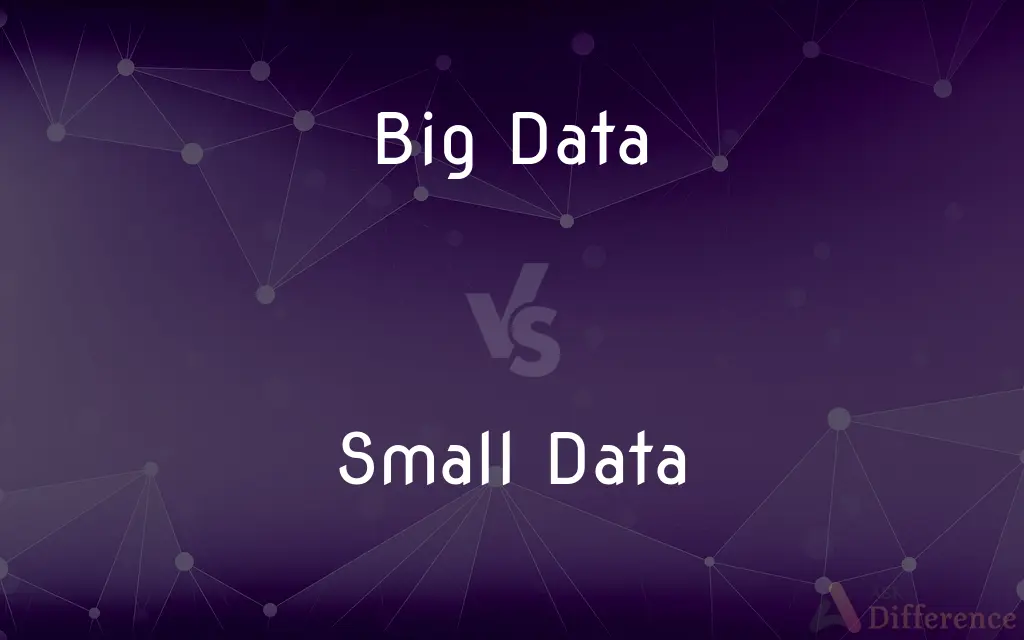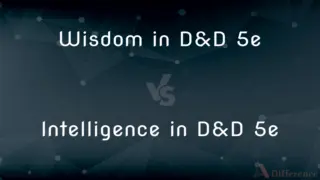Big Data vs. Small Data — What's the Difference?
By Fiza Rafique & Urooj Arif — Published on March 2, 2024
Big Data involves large volumes of complex data from diverse sources, analyzed for insights and trends, whereas Small Data focuses on accessible, understandable datasets used for actionable insights on a human scale.

Difference Between Big Data and Small Data
Table of Contents
ADVERTISEMENT
Key Differences
Big Data refers to extremely large datasets that are analyzed computationally to reveal patterns, trends, and associations, especially relating to human behavior and interactions. This data is characterized by its volume, velocity, and variety, often requiring advanced tools and technologies for processing and analysis.
Small Data, by contrast, consists of datasets small enough for human comprehension and analysis, focusing on providing actionable insights directly applicable to decision-making processes.
The collection and storage of Big Data utilize sophisticated database systems, capable of handling vast amounts of unstructured and structured data from varied sources. Small Data, however, can often be managed with simpler, more traditional data management tools, emphasizing ease of access and interpretation.
In terms of application, Big Data is often used in contexts requiring complex predictive analytics, such as trend forecasting in industries like finance, healthcare, and retail. Small Data plays a crucial role in day-to-day business decisions, marketing strategies, and in areas where direct, human-centric insights are needed.
Big Data analytics rely on machine learning algorithms and artificial intelligence to process and analyze the data, seeking patterns that are not immediately obvious to humans. Small Data, conversely, lends itself to straightforward analysis techniques, often visual, allowing for quick interpretation and application in various scenarios.
ADVERTISEMENT
The value of Big Data lies in its ability to provide comprehensive insights over broad spectrums, predicting behaviors or outcomes on a large scale. Small Data’s value is found in its immediacy and relevance to specific problems or questions, offering clear, actionable solutions without the need for complex computational analysis.
Comparison Chart
Volume
Extremely large datasets
Smaller, manageable datasets
Complexity
High, with structured and unstructured data
Low, easily understandable and manageable
Analysis Tools
Advanced analytics, AI, machine learning
Simple statistical tools, visual analysis
Application
Predictive analytics, trend forecasting
Immediate decision-making, actionable insights
Insight Generation
Automated, algorithm-driven
Human-driven, direct
Compare with Definitions
Big Data
Extensive datasets analyzed for complex insights.
Big Data is used in climate research to predict weather patterns.
Small Data
Focuses on simplicity and direct application.
Small Data helps schools improve teaching methods based on student performance.
Big Data
Characterized by volume, velocity, and variety.
Social media generates Big Data through the vast amount of user interactions.
Small Data
Human-scale, emphasizing clear, immediate insights.
Fitness apps use Small Data to provide users with personalized health tips.
Big Data
Requires advanced processing technology.
Companies use Big Data analytics to process customer data for marketing strategies.
Small Data
Directly influences day-to-day decisions.
Restaurants use Small Data to adjust menu items based on popularity.
Big Data
Useful in predictive analytics and trend spotting.
Retailers analyze Big Data to forecast upcoming shopping trends.
Small Data
Can be analyzed without specialized tools.
Marketers use Small Data for targeted advertising campaigns.
Big Data
Aimed at understanding broad patterns and behaviors.
Healthcare providers use Big Data to track disease spread patterns.
Small Data
Easily manageable datasets for actionable insights.
A small business uses Small Data to analyze customer feedback.
Common Curiosities
What is Big Data?
Big Data refers to extremely large datasets analyzed to reveal patterns, trends, and associations, especially relating to human behavior.
Can Small Data be part of Big Data?
Yes, Small Data can be a subset of Big Data, representing specific, understandable portions of larger datasets.
How do Big Data and Small Data differ in application?
Big Data is used for complex predictive analytics across various industries, while Small Data is applied to immediate decision-making and actionable insights.
Do Big Data and Small Data require different tools?
Yes, Big Data requires advanced analytics and processing tools, while Small Data can often be analyzed with simpler, more intuitive methods.
Why is Big Data important?
Big Data is crucial for understanding complex patterns and forecasting trends in various fields, from business to healthcare.
What challenges are associated with Big Data?
Challenges include data storage, analysis complexity, and ensuring privacy and security of the data.
How do companies collect Big Data?
Companies collect Big Data from various sources, including online transactions, social media, sensors, and more, often in real-time.
Is Small Data easier to manage than Big Data?
Yes, due to its smaller volume and complexity, Small Data is generally easier to manage and interpret.
What is Small Data?
Small Data is about datasets small enough for human analysis, focusing on providing actionable insights on a human scale.
Which is more valuable, Big Data or Small Data?
Both have their value, with Big Data offering broad, predictive insights and Small Data providing direct, actionable intelligence.
Can Small Data improve customer experiences?
Absolutely, Small Data can tailor customer experiences by providing insights into specific preferences and behaviors.
How is Small Data used by businesses?
Businesses use Small Data for direct, actionable insights to make immediate decisions and strategies.
What role does visualization play in Small Data analysis?
Visualization plays a key role in making Small Data accessible and understandable, facilitating quick decision-making.
How can Small Data contribute to personalized marketing?
Small Data allows for targeted marketing efforts by providing detailed insights into individual customer preferences and behaviors.
How do advancements in AI impact Big Data analysis?
AI advancements make Big Data analysis more efficient and accurate, enabling deeper insights and automation of complex processes.
Share Your Discovery

Previous Comparison
Wisdom in D&D 5e vs. Intelligence in D&D 5e
Next Comparison
Conductors vs. InsulatorsAuthor Spotlight
Written by
Fiza RafiqueFiza Rafique is a skilled content writer at AskDifference.com, where she meticulously refines and enhances written pieces. Drawing from her vast editorial expertise, Fiza ensures clarity, accuracy, and precision in every article. Passionate about language, she continually seeks to elevate the quality of content for readers worldwide.
Co-written by
Urooj ArifUrooj is a skilled content writer at Ask Difference, known for her exceptional ability to simplify complex topics into engaging and informative content. With a passion for research and a flair for clear, concise writing, she consistently delivers articles that resonate with our diverse audience.
















































